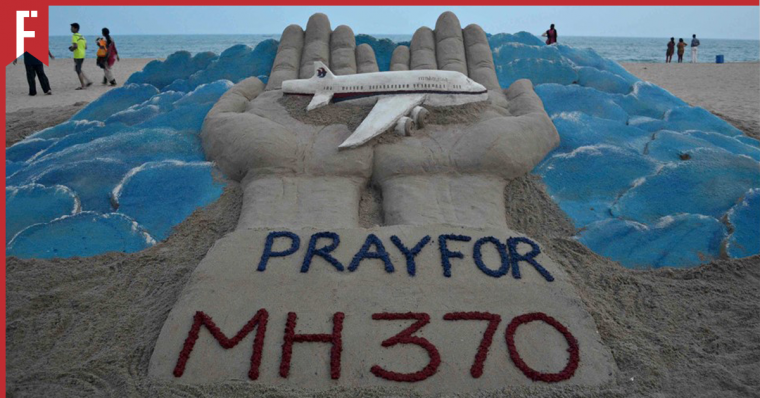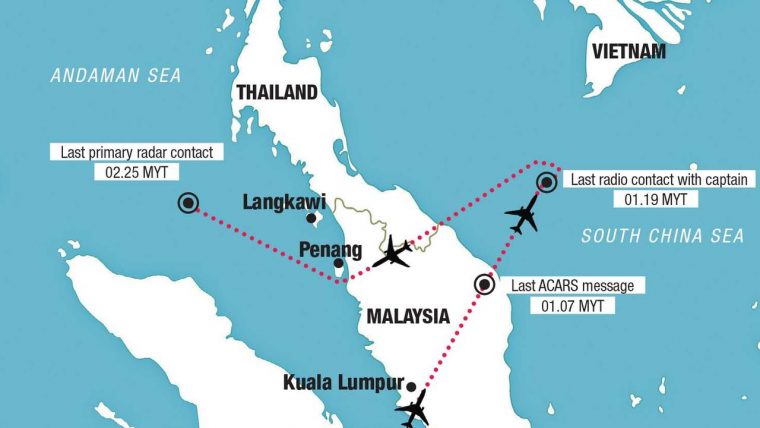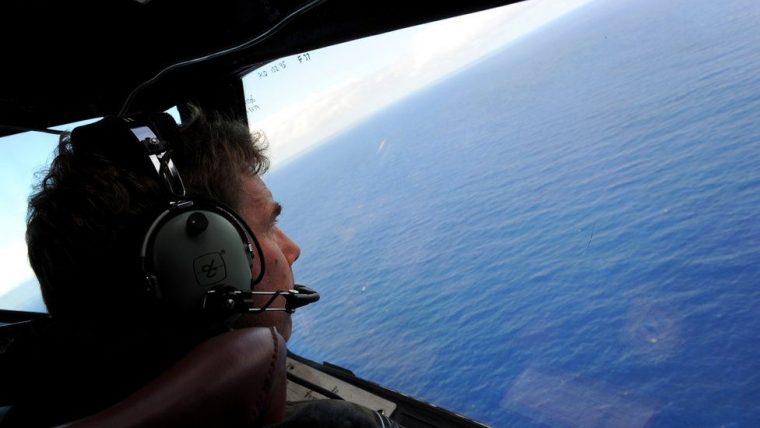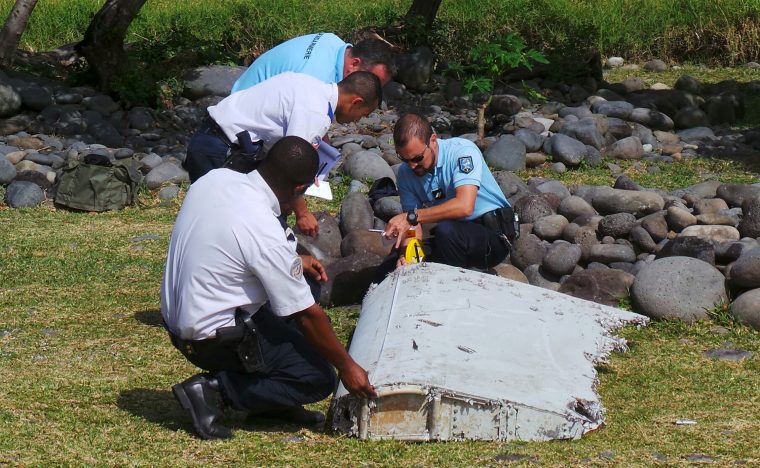
When you tell a foreigner that you’re from Malaysia, the two most common responses are: “Malaysia? Where’s that?” or “Oh, is that the country next to Singapore?”
Alternatively, they might ask “Isn’t that the place with the missing airplane?”
For those old enough to remember the MH370 incident unfolding, it can be startling to realise just how long it’s been. I still remember when it felt like the plane was being mentioned every day on every news station. But after everything that’s happened since start of the COVID-19 pandemic, MH370 feels like something from a hundred years ago.
As the MH370 incident’s eighth anniversary draws closer, let us take a moment to reflect on one of the greatest mysteries of the modern aviation world.
A Brief Timeline of MH370

Our story begins on 8 March 2014, when what was supposed to be a normal flight suddenly goes badly wrong:
- 12.41am: Malaysia Airlines Flight 370 (aka MH370) departs from Kuala Lumpur International Airport on a scheduled flight to Beijing. On board are 227 passengers and 12 crew members.
- 1.01am: The plane reaches its cruising altitude of 10,700 meters.
- 1.07am: The plane’s Aircraft Communication Addressing and Reporting System (ACARS) releases its last transmission regarding the plane’s performance before being switched off.
- 1.19am: MH370’s pilot tells the air traffic controllers “All right, good night”. These are the last words that anyone will ever hear from them.
- 1.21am: The plane’s transponder (used to communicate with air traffic control) is switched off just before the plane was about to enter Vietnamese airspace.
- 1.30am: Malaysian military radar spots the plane making a U-turn. It turns from its original northeastern course and starts heading westward instead.
- 2.25am: MH370 leaves the range of military radar while over the Andaman Sea, roughly 370km northwest of Penang.
- 6.30am: MH370 misses its scheduled arrival at Beijing Capital International Airport. The Kuala Lumpur Aeronautical Rescue Coordination Centre (ARCC) is activated.
- 7.24am: Malaysia Airlines issues a press statement announcing that the plane has gone missing.
- 8.11am: The plane’s last signal is detected by an Inmarsat (a British satellite communications company) satellite in geostationary orbit over the Indian Ocean.
The Search for MH370 Starts Off… Poorly

Just hours after Malaysia Airlines’ press statement, an international group is brought together in order to track down the missing plane and rescue anyone they could.
Unfortunately, the search party is plagued with miscommunication and a lack of coordination from the very beginning. International rescuers began by scouring the South China Sea and the Gulf of Thailand as that was the area where the plane initially lost contact with air traffic control.
However, on 12 March — four days after the plane had disappeared, the Royal Malaysian Air Force releases a report of an unidentified plane believed to be MH370 that had been spotted flying westwards rather than northwards.
Aside from that, on 11 March Inmarsat provided officials with data suggesting that the plane had been in the Indian Ocean. However, this information was not acknowledged until Prime Minister Najib Razak released it during a press conference on 15 March!
Needless to say, the other rescuers were rather put off. The Chinese authorities in particular criticised Malaysia’s “chaotic” release of important information.
“As Malaysia Airlines is state-owned, the Malaysian government is the core force in the fact-finding mission,” reported the state-run Xinhua news agency. “Unless transparency is ensured, the huge international search operation can never be as fruitful as we hope and expect.”
To make matters worse, the search efforts were hampered by a general lack of trust between the different countries involved.
“The rate at which they can take the picture can also reveal how good the radar system is,” said Singapore-based aviation expert Terence Fan. “That I think is probably why the countries around here are not very fond of sharing the information.”
The Most Expensive Aviation Search in History

The hunt for MH370 was an international effort, with 26 countries contributing planes, ships, satellites and even submarines. Unfortunately, all of this high-tech gear would come at a price — literally.
In just one month, the search effort had spent an estimated $44 million. With every day that the plane remained missing, the price tag only continued to grow bigger.
“The search effort for MH370 is costing the Australian Defence Force (ADF) at least A$800,000 per day and possibly considerably more than that,” warned Kym Bergmann, editor of Asia-Pacific Defence Reporter and a former government defence adviser.
“While that might not sound like much compared with the ADF’s annual sustainment budget of A$5 billion, if this continues for much longer other activities… will be under pressure to find savings.”
Aside from Australia, China and the United States were also footing a large portion of the bill. During a press conference in April 2014, Chinese authorities declined to comment on how much they spent, declaring that they would keep searching for their missing citizens “as long as there is a shred of hope”.
However, foreign experts estimated that their warships could cost up to $100,000 a day to operate.
The Americans, on the other hand, revealed that they had spent more than $3.3 million out of their original $4 million budget during the first month of the search.
Bear in mind that all of these numbers are just from the first month of the search. By the time the search was suspended on January 2017, it is estimated that the operation had cost a whopping A$200 million (approximately RM607 million today).
What Happened to MH370?

Despite one of the largest surface and underwater search efforts in aviation history, the international search team failed to track down the final resting place of Flight MH370. In the end, only a few small pieces of debris from the plane would be found washed up on islands in the Indian Ocean.
Even after all these years, many questions remain. What exactly happened to Flight MH370? What caused it to suddenly change course? Most importantly, what happened to all the passengers and crew?
Over the years, many theories have been suggested. Many of them are nothing more than conspiracy fever dreams, but there have been a few plausible ideas. Putting aside all the crazy “aliens did it!” ideas, here are a few of the most common suggestions:
Theory 1: Fire
One of the more popular theories is that there was a fire on board that killed everyone inside before the plane crashed. The plane’s course change could have been the pilots turning back to attempt an emergency landing after the plane caught fire. Supporters of this theory point to the fact that the plane’s cargo included 221kg of lithium-ion batteries, which have been known to cause intense fires if they overheat and ignite.
Theory 2: Mechanical Failure
Another suggestion is that the plane could have suffered a mid-air breakup due to cracking and corrosion. On 5 March 2014, the Federal Aviation Administration (FAA) ordered checks on hundreds of US-registered Boeing 777s after reports of cracking in the fuselage skin beneath the satellite antenna.
Theory 3: Terrorist Attack
Ever since the 9/11 incident, people across the world have been paranoid about the possibility of terrorists hijacking planes. When news came out that two of Flight 370’s passengers were using stolen passports, many suspected the worst. However, an Interpol investigation concluded that the two men were most likely asylum seekers rather than terrorists.
Theory 4: Suicidal Pilot
During the investigation, Malaysian police searched the homes of every pilot and crew member. While most of them didn’t reveal anything useful, Captain Zaharie Ahmad Shah’s home flight simulator raised some red flags when FBI analysts found a route on the computer that “closely matched” the projected flight over the Indian Ocean.
However, Zaharie was later cleared of blame in the 2018 safety investigation report on MH370, which stated that there had been nothing negative found regarding his character, work or professional record.
Will We Ever Learn the Truth?

The fate of MH370 is one of the biggest mysteries in modern aviation history. Despite the efforts of international investigators, we have come no closer to discovering the truth even eight years later.
On 18 February 2022, the Malaysian government declared that it might be willing to launch a new search mission based on a report submitted by British aeronautical engineer Richard Godfrey, who claims that he has identified new leads on the missing plane’s location.
After all these years, perhaps we will finally be able to solve the mystery and lay the memories of MH370 to rest once and for all.
If you want to know about some of the other big disasters in Malaysia’s past, be sure to check out:
3 Terrorist Attacks in Malaysia You Didn’t Know About









